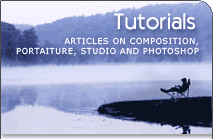This article belongs completely to Ed Shapiro, a professional photographer, who contributed a lot to the art. It is based on the content of a topic of forum. I have to thank Ed for covering this topic. I could not find any place where Ed gathered and published his knowledge, so I decided to extend the audience of the forum where he posted this topic. So here it goes...
Standard Exposures
What I have done in my camera room, to simplify things and get constantly good exposures, is complete exposure standardization. My standard color neg. material is Kodak Portra NC160 @ ISO 125 — Black and white for general portraiture is Plus-X Pan @ ISO 125 — and Color Transparency — Ektachrome + @ ISO 100 for commercial still life, architecture and catalogue work. For low key black and white portraiture I love Verichrome Pan roll-film — it has and awesome brightness range — especially when processed in Pyro developer. The Plus-X gives you brilliant negatives when developed in HC110 (dilution B) for 5 minutes at 20C with gentle agitation for 5 seconds every 30 seconds. My color neg. and black and white film indexes, in studio, give me f11. I don't have to meter all the time — only to verify that all the lights are working at the proper output. I expose for the shadows and print for the highlights thereby giving me complete ratio control. With the chrome — I do meter, especially when doing more complex table-top work and I make Polaroids as well. For more saturation, I underexpose about 1 stop. For flatter results I overexpose by 1 stop and ask for 1 stop pull processing. Bracketing and Polaroid testing, in all cases, is essential when you are doing table top work because there are other factors such as bellows extension, filters, and polarizers which can all alter exposure. I have derived all this by testing — lots of it. But it's nice to be able to go from one job to the other knowing that the technical stuff is all ship shape and there is more time to concentrate on the subject. ![End of the article [end of the text]](http://www.romanzolin.com/img/misc/text_end_ed.png)





